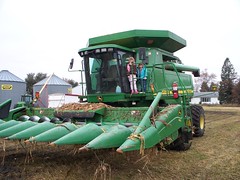Business Wisdom from the Farm: Planting Season
Author: Jeremy Harrison
If I were forced to either forget everything I learned in college, OR forget everything I learned on the farm as a child, I wouldn’t think twice. Early lessons on the farm were far more valuable.
Things that seemed like common sense as a kid now seem profound. Here’s a simple example.
Planting and Harvest.
 When I was young, my favorite time of year on our farm was harvest season. I loved riding on the combine with dad. The combine is a massive, powerful machine. Corn fields are harvested six, eight, even twelve rows at a time. The stalks are cut, the cob is removed from the stalk, the corn is stripped from the cob. Trucks and trailers are quickly filled to the brim with corn.
When I was young, my favorite time of year on our farm was harvest season. I loved riding on the combine with dad. The combine is a massive, powerful machine. Corn fields are harvested six, eight, even twelve rows at a time. The stalks are cut, the cob is removed from the stalk, the corn is stripped from the cob. Trucks and trailers are quickly filled to the brim with corn.
Part of my joy in harvest season was gazing through the large glass window and watching the combine work its magic. But the part I loved most was the mood of my dad and the whole family. It was the well-deserved payoff after months of hard work.
 As I look back, I realize that planting season felt different. Farm families invest a fortune on seed, spray, fuel and labor. When dad would first plant a field, the field still looked empty. There was very little to show for his work. But something was happening under the surface. We would pray for the right combination of rain, dry conditions, and then more rain. We wanted occasional rains in the summer, followed by heat. We wanted cool nights in the fall. If everything went perfectly, the return on investment was huge. But I remember years when we had too much rain. Other years we had none at all.
As I look back, I realize that planting season felt different. Farm families invest a fortune on seed, spray, fuel and labor. When dad would first plant a field, the field still looked empty. There was very little to show for his work. But something was happening under the surface. We would pray for the right combination of rain, dry conditions, and then more rain. We wanted occasional rains in the summer, followed by heat. We wanted cool nights in the fall. If everything went perfectly, the return on investment was huge. But I remember years when we had too much rain. Other years we had none at all.
Farming is risky. I know these risks were always on dad’s mind when he planted in the spring. But, can you imagine the satisfaction when it worked?
You make the investment, you do the hard work, you wait, and you get results. This is where the joy of farming comes from.
Planting Season in a Small Business.
Organizations that stand the test of time have leaders who recognize the importance of “planting” before “harvesting.” Here are four guidelines for establishing profitable planting seasons in your organization:
- Find the seed planting activity in your business. It’s easy to avoid seed planting because it requires a lot of work without much to show for it. In my business, I create content that helps small businesses. I write articles, create videos and develop seminars. Much of this content is shared for free. This is my seed planting — work that has great potential of growing into something profitable in months and years to come. Identify this work in your business, and make time to do it.
- Plant Early. My first five years in business felt like a lot of planting and very little harvesting. It can be scary to put it all on the line and pour limited resources into “seeds” that have no guarantee of turning into anything. You’re constantly reminded of the risks — many beyond your control — which threaten your survival. One way or another, you must find a way to plant seeds, even in those first few years when you need instant results.
 Avoid Shortcuts. I meet entrepreneurs who try to shortcut past planting season and skip straight to harvest. Sure, there are a few things you can grow quickly with very little effort. But what grows isn’t worth much. Be careful that you don’t allow these distractions to crowd out true seed planting work.
Avoid Shortcuts. I meet entrepreneurs who try to shortcut past planting season and skip straight to harvest. Sure, there are a few things you can grow quickly with very little effort. But what grows isn’t worth much. Be careful that you don’t allow these distractions to crowd out true seed planting work.
- Plant Regularly, But Not Constantly. When your business starts to grow, it’s tempting to “ride the combine” and watch the machine run. But this is not sustainable. You must continue to plant seeds, to prepare for even larger harvest seasons in the future. As your business grows, hire others to do the harvest work and set aside more of your time as a leader to plant. But don’t plant constantly. Recognize that planting is a “season.” Schedule focused times to plant, times to cultivate, and times to rest and observe how the seeds are growing.
Whether you want to start a business from scratch, or squeeze another 10% out of a large company, leaders must schedule time for planting. The work won’t get the results you need today. But many of these seeds will bring exponential returns later.
You make the investment, you do the hard work, you wait, and you get results. This is where the joy of being an entrepreneur comes from.
